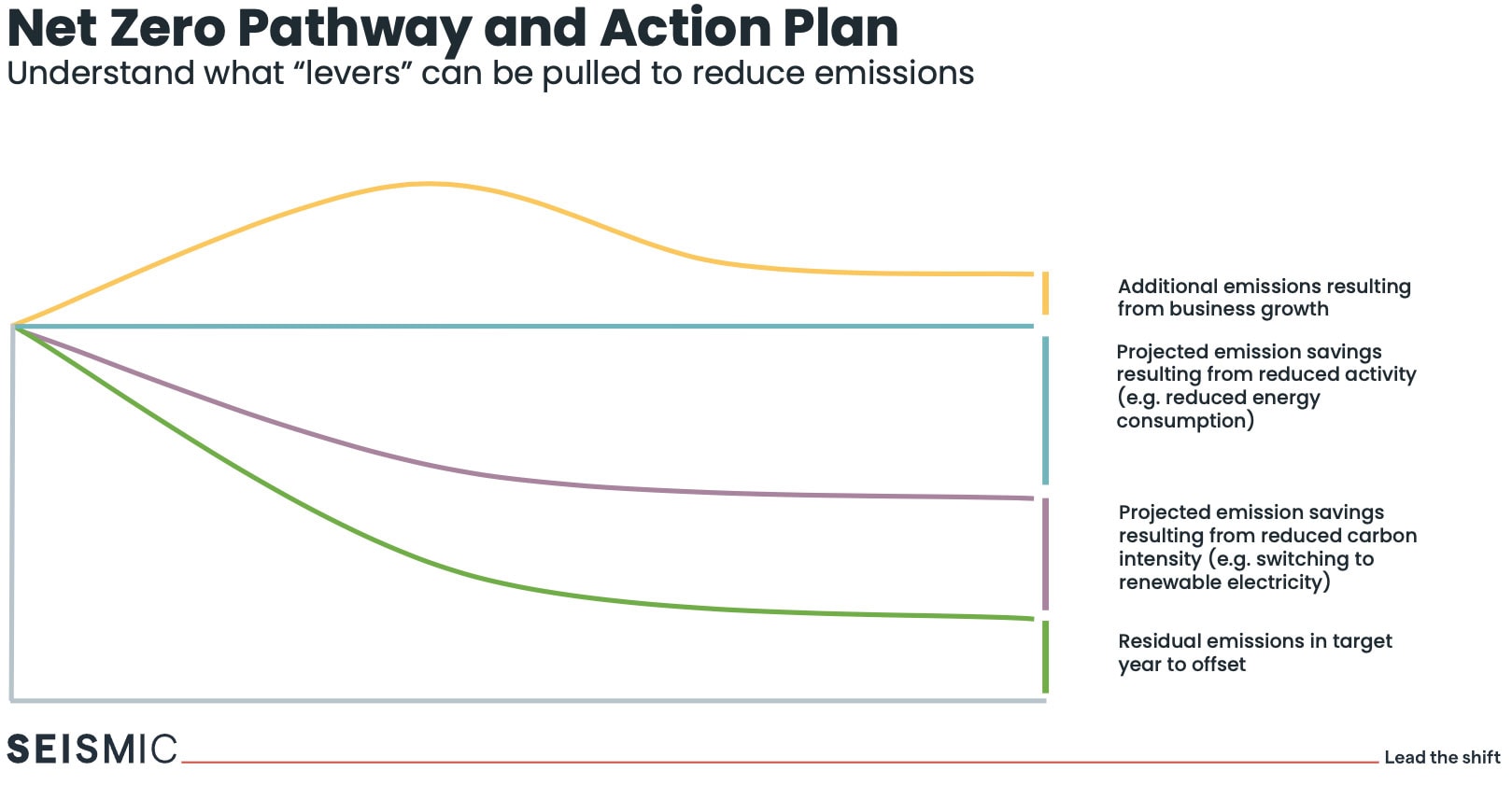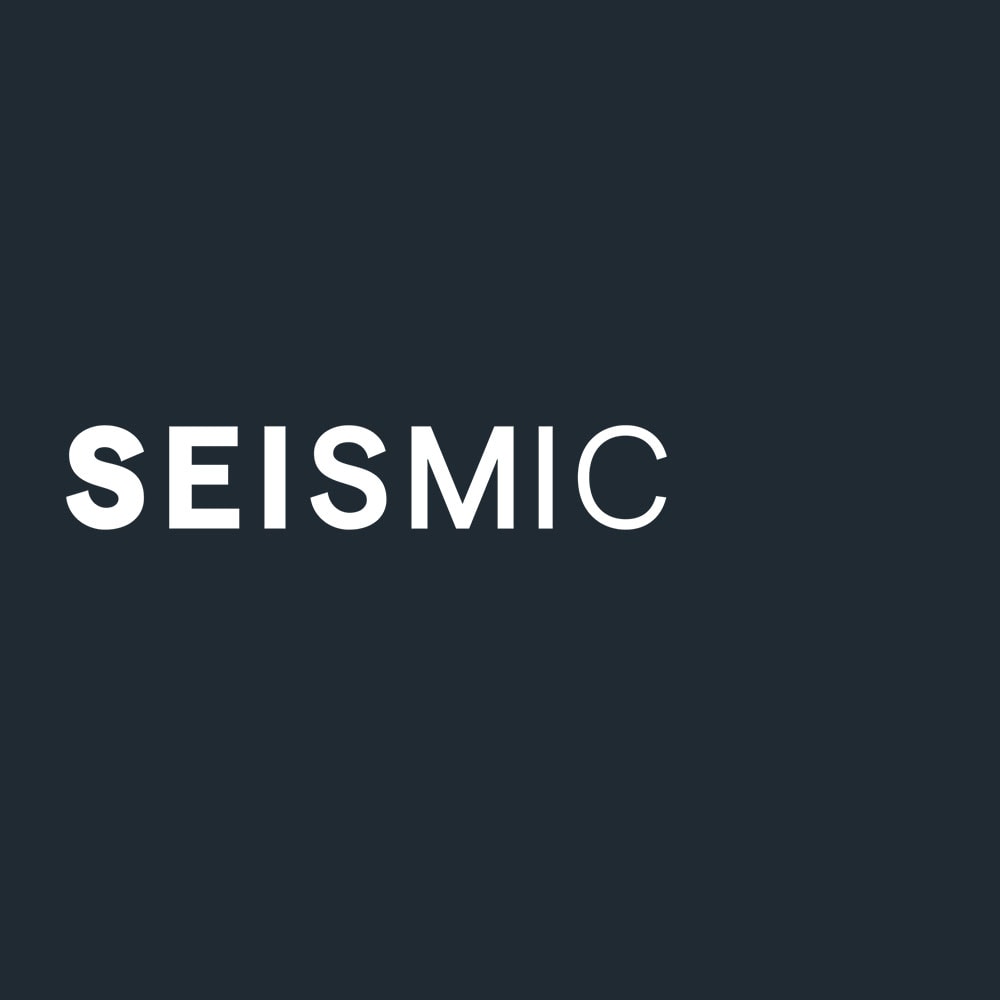
At Seismic, we advise and bring together communities from both the B Corp and net zero movements. It’s undeniable that the two missions are in alignment and a number of brilliant working collaborations reiterate this. Just earlier this month the We Mean Business Coalition and B Lab, announced a new partnership to accelerate progress in cutting greenhouse gas (GHG) emissions worldwide. We work with lots of passionate people and have gathered expertise in this article to demystify and discuss their journeys in both B Corp and net zero, and have generated top tips on how to approach net zero whilst considering the challenge of business growth.
Net zero considerations
The theoretical method to net zero can be laid down very simply:
- Measure – Measure your carbon footprint on Scopes 1, 2 and 3
- Action Plan – You’ll then follow a net zero pathway and action plan
- Target – Submit a net zero target
Although in reality, the execution of this is a lot more involved.
Scope 1, 2 and 3 emissions
Scoping takes into consideration all direct and indirect carbon emissions associated with an organisation’s value chain and significantly those emissions which should be within an organisation’s operational control
Understanding what’s within your operational control can give a company the ability to influence and drive reduction within those emissions.
- Scope 1 emissions cover your direct emission releases. That’s you as a business directly releasing greenhouse gases into the atmosphere that’s typically through things like heating within buildings or fleets of vehicles, and it can also cover a refrigerant top-up as well.
- Scope 2 is electricity consumption, renewable and non-renewable energy.
- Scope 3 includes emissions that can add up to around 90% of a company’s emissions. Business travel, employee commuting, goods and services purchased, transportation distribution and much more.
Creating a robust structure for collecting and reporting on the data found in the scoping exercise is essential for comparing like-for-like emissions.
The net-zero pathway compares the projected emissions, if your company makes no changes. The pathway develops a way to view predicted additional emissions if the business grows, projected savings resulting from reduced carbon intensity, and residual emissions in target years to offset.

Setting targets
- Lowest ambition is carbon neutrality
- measuring your organisation’s footprint annually and making high-quality carbon offsets. This doesn’t include particularly active steps.
- Near Term SME Science Based Target
- measure footprint annually and commit to an emissions reduction target for 2030, of 50% Scope 1 and 2 reduction and absolutely no Scope 3 emission growth. Every year companies need to reduce and report on organisational windows like the target window, they’re then encouraged to offset those residual missions when the target year is achieved.
- Near Term SME Science Based Target
- measure footprint annually and set a Science Based emission reduction target for 2030 with a commitment of 50% Scope 1 and 2 reduction and 50% Scope 3 reduction. It’s about tackling initial reduction in the data.
- Long Term SME Science Based net zero Target
- This is the gold standard of target initiatives. You’re committing to a 90% emissions reduction, irrespective of company size, by 2050.
How net zero ties into B Corp
Depending on your business activities, your net zero journey can make up about 20% (or more) of your B Impact Assessment (BIA). That includes all of the Air requirements, a significant part of the Environmental Management section (EMS), part of the Water and part of the Land and Life section. Although environmental management, water and land and life might not seem directly linked to net zero, this is all part of linking, monitoring and managing, and tackling your environmental impacts, which absolutely does feed in. So it’s all supporting the net zero objective.
The questions that are covered under these sections in the BIA include potential products with life cycle footprint and assessments, monitoring of energy consumption and monitoring of greenhouse gas emissions. Your total Scope 3 footprint is around supply chain, greenhouse gas management and the monitoring and improvement of that footprint.
There are proposed changes to be made to the B Corp standard, to be implemented in late 2024, following current collective feedback from the community. The proposed standards look to include B Corps taking climate action in accordance with the science, and putting an environment management system (EMS) in place that demonstrates their commitment to reducing their footprint. So this alignment will continue to gain importance.
Top tips to get started in net zero
Start with the end in mind – to help not spend a disproportionate amount of time and effort, measuring areas that are not material. Concentrate on what’s your most material impact and prioritise those.
Bring people with you – Carbon is as much about people as it is about data. It’s about engaging the internal team, the supply chain, and those data owners really key to being able to pull the picture together.
Build your carbon journey into your broader sustainability strategy, or even better merging them – The B Corp framework enables you to do this, it makes good business sense and is increasingly being seen as the direction of travel.
Practical next steps to start your carbon journey
- Measure Scopes 1,2 and 3
- Develop an action plan which covers all scopes.
- Sign up to the B Corp Climate Collective
Your company’s net zero aspirations
We spoke to a few different organisations about their net zero journeys. Francis Thomas is the Chief Sustainability Officer at Kerv, a tech services provider, whose mission is to use the power of technology for good. Kerv are a two-year-old business, who are managing environmental impact. In the second year of emissions measurement, they’re beginning to work through a reduction strategy. This is all about supply chain, with 96% of emissions in purchase goods and services. They’ve also introduced emissions reporting on an MI data for emissions on a monthly basis.
Kate Sandle, Director of Sustainability at Newcore Capital Management, a B Corp certified investor specialising in social infrastructure and real estate management, explained they work primarily with buildings which are in Scope 3, with very small Scope 1 & 2. They’ve been measuring that, leading to them being climate neutral for the last couple of years, through triple offsetting their tiny amount of emissions. Kate’s advice included working on getting actual data to use as a benchmark and include the nuances of how it’s invested.
Liz Lown is the Operations Director at HG&Co, a forward thinking, sustainable, independent family business. They manufacture Hayman’s Gin and Co. as well as other alcohol brands and ethanol for industrial purposes. Liz told us of their environmental aspirations. An aspiring B Corp, they started their B Corp journey to eliminate gas from their sites. They’ve been focusing on Scope 1 and 2 predominantly as well as focusing on minimising waste and avoiding landfill. That’s helping with their submission and how to meet targets in their EMS. They’re also taking a holistic approach involving focusing on the products and components they make and how they can use more sustainable and recyclable elements.
How B Corp has affected the net zero journey?
(and the challenges of growth in net zero targets)
We spoke to Francis Thomas about Kerv’s experience “If emission reductions come before the B Corp certification, the B Corp journey can be made easier and supports a good score. One way to reduce emissions is to stop growing as a business, we weren’t ever going to do that, so measures need to be considered in how to get good results and be brave. Starting your net zero focus as soon as you can after business conception will help deliver no new emissions within new products/services/partnerships. Keep close scrutiny of people and suppliers that you work with, to ensure they are happy to change too, even though it takes investment and they’re not easy things to do.”
Some of the big net zero challenges
Setting absolute or intensity targets.
SBTis can be difficult depending on what type of business you are. Working on absolute reduction may not always align with organisations with big growth ambitions. Other pathways are possible.
For some businesses finding a baseline through spreadsheets can support seeing current situations and set intensity based targets.
An absolute target is to say, 100 tonnes of carbon is being released and that figure needs reducing year on year. An intensity target is tied to a physical unit, i.e. litres of product produced, and you need to reduce emissions related to the amount of ‘stuff’ produced.
Awareness
Bringing people with you and governance can be huge challenges. Getting buy-in from all your stakeholders is necessary and getting the mission the attention it deserves is needed. And if all of your emissions are Scope 3 and within the assets you own, then full control over external elements can be hard to manage.
Always ask for help
HG&Co had to replace building roofs to ensure they would support solar panels. As members of a local industrial group, they were connected with a Government-funded initiative that offered valuable support and guidance on the preparation and installation of solar panels. This collaboration supported a quicker way of getting round that challenge.
Top advice from our contributors for your net zero journey
- People engagement is essential. Within HG&Co, all team members are encouraged to contribute to their respective departments by generating sustainable ideas, which have become part of the KPI for everyone involved.
- Engage with your supply chain. Knowing who you’re spending your money with is essential to avoid nasty surprises.
- Be prepared for tough conversations on the future of the business. Recognition of what you’re doing is how you’ll future proof your impact on the planet. So be courageous!
Your carbon partner
Seismic supports businesses to measure and reduce their carbon footprint, and also build their wider sustainability strategies. We can be your partner for change, with an exceptional talent to make the complex simple. If you’d like support progressing your carbon ambitions, get in touch.
Watch the recording
If you missed the breakfast briefing, you can watch the recording below. Seismic holds monthly breakfast briefings to inform and inspire our community. Sign up for our monthly newsletter to receive invites to upcoming Seismic Breakfast Briefings.

